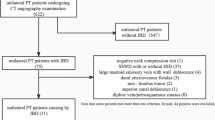Abstract
Objectives
To evaluate the characteristics of sigmoid plate dehiscence (SPD) causing pulsatile tinnitus (PT) on CT arteriography and venography (CTA + V).
Methods
Thirty PT patients treated successfully with SPD reconstruction were enrolled. Sixty asymptomatic patients were matched. The location, extent, number of SPD cases and concomitant signs, including venous outflow dominance, transverse sinus stenosis, high jugular bulb, temporal bone pneumatization, height of pituitary gland and pituitary fossa, abnormal mastoid emissary vein, were detected and compared using CTA + V.
Results
More than one SPD was found on the symptomatic side in 13/30 PT patients (43.3 %). The upper segment of the sigmoid plate was involved in 29/44 SPDs in the vertical direction (65.9 %); the lateral wall was involved in 38/44 SPDs in the horizontal direction (86.4 %). Singular SPD was detected in 3/60 asymptomatic patients (1.67 ± 0.35 mm2), less so in PT patients (7.97 ± 5.17 mm2). Compared with the control group, ipsilateral venous outflow dominance, high jugular bulb and bilateral transverse sinus stenosis were more common in the PT group, together with deeper pituitary fossa and flatter pituitary glands.
Conclusion
SPD causing PT has characteristic CT findings. It may be generated by vascular or intracranial pressure abnormalities and act as a common key to triggering PT’s perception.
Key Points
• Pulsatile tinnitus (PT) caused by sigmoid plate dehiscence (SPD) may be cured.
• SPD causing PT has some characteristic findings on CT.
• SPD may be a common key to triggering PT’s perception.
• Thin-slice high resolution CT venography is recommended for SPD assessment.
• The relationship between intracranial pressure and SPD causing PT should be studied.



Similar content being viewed by others
Abbreviations
- SPD:
-
Sigmoid plate dehiscence
- SSD:
-
Sigmoid sinus diverticulum
- TBP:
-
Temporal bone pneumatization
- IH:
-
Intracranial hypertension
- HRCTV:
-
High resolution CT venography
References
Lockwood AH, Salvi RJ, Burkard RF (2002) Tinnitus. N Engl J Med 347(12):904–10
Krishnan A, Mattox DE, Fountain AJ, Hudgins PA (2006) CT arteriography and venography in pulsatile tinnitus: preliminary results. AJNR Am J Neuroradiol 27(8):1635–8
Branstetter BF 4th, Weissman JL (2006) The radiologic evaluation of tinnitus. Eur Radiol 16(12):2792–802
Madani G, Connor SE (2009) Imaging in pulsatile tinnitus. Clin Radiol 64(3):319–28
Vattoth S, Shah R, Curé JK (2010) A compartment-based approach for the imaging evaluation of tinnitus. AJNR Am J Neuroradiol 31(2):211–8
Mundada P, Singh A, Lingam RK (2014) CT Arteriography and Venography in the Evaluation of Pulsatile Tinnitus with Normal Otoscopic Examination. Laryngoscope. doi: 10.1002/lary.25010. [Epub ahead of print]
Hofmann E, Behr R, Neumann-Haefelin T, Schwager K (2013) Pulsatile tinnitus: imaging and differential diagnosis. Dtsch Arztebl Int 110(26):451–458
Schoeff S, Nicholas B, Mukherjee S, Kesser BW (2014) Imaging prevalence of sigmoid sinus dehiscence among patients with and without pulsatile tinnitus. Otolaryngol Head Neck Surg 150(5):841–6
Koesling S, Kunkel P, Schul T (2005) Vascular anomalies, sutures and small canals of the temporal bone on axial CT. Eur J Radiol 54(3):335–43
Eisenman DJ (2011) Sinus wall reconstruction for sigmoid sinus diverticulum and dehiscence: a standardized surgical procedure for a range of radiographic findings. Otol Neurotol 32(7):1116–9
Xue J, Li T, Sun X, Liu Y (2012) Focal defect of mastoid bone shell in the region of the transverse-sigmoid junction: a new cause of pulsatile tinnitus. J Laryngol Otol 126(4):409–13
Santa Maria PL (2013) Sigmoid sinus dehiscence resurfacing as treatment for pulsatile tinnitus. J Laryngol Otol 127(Suppl 2):S57–9
Wang GP, Zeng R, Liu ZH et al (2014) Clinical characteristics of pulsatile tinnitus caused by sigmoid sinus diverticulum and wall dehiscence: a study of 54 patients. Acta Otolaryngol 134(1):7–13
Grewal AK, Kim HY, Comstock RH 3rd, Berkowitz F, Kim HJ, Jay AK (2014) Clinical presentation and imaging findings in patients with pulsatile tinnitus and sigmoid sinus diverticulum/dehiscence. Otol Neurotol 35(1):16–21
Mattox DE, Hudgins P (2008) Algorithm for evaluation of pulsatile tinnitus. Acta Otolaryngol 128:427–31
Moonis G, Kim A, Bigelow D, Loevner LA (2009) Temporal bone vascular anatomy, anomalies, and disease, with an emphasis on pulsatile tinnitus. In: Swartz JD, Loevner LA (eds) Imaging of the temporal bone, 4th edn. Thieme, New York, NY, pp 247–297
Otto KJ, Hudgins PA, Abdelkafy W, Mattox DE (2007) Sigmoid sinus diverticulum: a new surgical approach to the correction of pulsatile tinnitus. Otol Neurotol 28(1):48–53
Sigari F, Blair E, Redleaf M (2006) Headache with unilateral pulsatile tinnitus in women can signal dural sinus thrombosis. Ann Otol Rhinol Laryngol 115(9):686–9
Liyanage SH, Singh A, Savundra P, Kalan A (2006) Pulsatile tinnitus. J Laryngol Otol 120(2):93–7
Riggeal BD, Bruce BB, Saindane AM et al (2013) Clinical course of idiopathic intracranial hypertension with transverse sinus stenosis. Neurology 80(3):289–295
Acknowledgements
The scientific guarantor of this publication is Zhenchang Wang. The authors of this manuscript declare no relationships with any companies whose products or services may be related to the subject matter of the article. This study has received funding by Grant 2012BA112B05 from the National Science & Technology Pillar Program during the Twelfth Five-year Plan Period of China, Grant 81171311 from the National Natural Science Foundation of China, Grant KZ20110025029 from the Beijing Municipal Commission of Education. No complex statistical methods were necessary for this paper. Institutional Review Board approval was obtained. Written informed consent was obtained from all subjects (patients) in this study. Methodology: retrospective, case-control study, performed at one institution.
Author information
Authors and Affiliations
Corresponding author
Rights and permissions
About this article
Cite this article
Zhao, P., Lv, H., Dong, C. et al. CT evaluation of sigmoid plate dehiscence causing pulsatile tinnitus. Eur Radiol 26, 9–14 (2016). https://doi.org/10.1007/s00330-015-3827-8
Received:
Revised:
Accepted:
Published:
Issue Date:
DOI: https://doi.org/10.1007/s00330-015-3827-8




